I’m a fan of the NFL. It occurred to me that there are a lot of parallels between an NFL team headed toward the Superbowl and a project headed toward go-live. (I’ll leave the Fantasy Football parallel to project management to Arnaud.)
Like at the start of the football season, a project initially staffs its team, outlines the objectives and goals, and begins working on its playbook. This is a particularly fluid time. During the season, anything can happen that will impact your team—injuries, firings, and trades. On a project, those might look like team members leaving or switching to another project.

For the coaches and leadership, the season objective stays the same: making it to the playoffs, or, in the case of a project: go-live. Week by week, the team focuses on its upcoming opponent (list of deadlines) and doesn’t look beyond those goals.
Each game factors into the overall record and, hopefully, moves the team toward the playoffs. There are, however, other outside factors that can influence the possibility of making the playoffs. When we’re talking football, it’s things like tied records, Wild Card games, and rooting for divisional rivals to win a game that can impact end results.
Projects have parallel challenges. On a project that is a string of implementations or transformations, it’s important to stay focused and not let extraneous variables impact keeping your eye on go-live.
There will also be personnel challenges of contracts ending, trades to other projects or jobs, or team members taking sick time. When you can’t rely on having the same team you started with, your date for go-live can stretch out further than planned as you ramp up new resources and get everyone realigned.
But if you stay the course and pay attention to the necessary changes that will keep you aligned with the goal, you’ll soon be headed to the Super Bowl.
Preparing for Game Day
While getting to the Super Bowl is an accomplishment and the journey to get there is long, the work is not done. Here, the last-minute details and preparations ensure that your game plan is buttoned up and ready for the match. Calendars fill up with pulling last-minute details together, press conferences, roster checks, and confirming roles come game time.
With a transformation project heading into cutover, similar final preparations are key: everyone realigns on their roles, tasks, and support. Everything is triple-checked to ensure everything is ready for go-live.
Game day has arrived, and while there’s a palpable energy of excitement, the work must continue. Despite having gone over your playbook with all the players, you know that your team will have to adapt based on what happens in real time.Your defense might struggle to cover, a player might get injured, or your defense may fail to read coverage. Here comes halftime. The team takes a water break and you as the coach walk through any shifts in strategy you need to move forward.
On a project, game day is your final cutover weekend when every team has to execute every required activity with seamless perfection of sequencing and synchronization. And issues always come up. A critical system defect shows up, physical equipment at one of your business sites malfunctions, a key expert falls ill and out of commission. If you’re the prepared type you have gone through contingency planning and while you don’t have half-time, your twice-a-day cutover checkpoints are your opportunity to adapt to the events on the ground and continue your drive to victory. .
Touchdown!
Congratulations! You’re now the Super Bowl Champions. Take a moment to pat yourselves on the back, but get ready for the next leg of work.
Now it’s time to prepare for off-season, or in the case of your project, hypercare. This is the phase where you’ll fill in the gaps for personnel, find any remaining bugs, and complete tasks that were pushed out past go-live. It’s this period that sets up next season for success.
Every football player dreams of having a Super Bowl championship under his belt. But one success isn’t the end goal. It’s being able to consistently deliver superior playing game after game (project after project) that makes for a great player.
Share:


